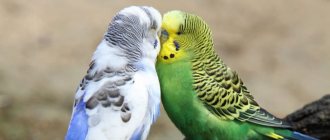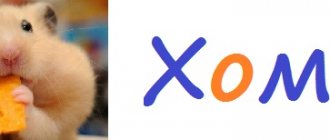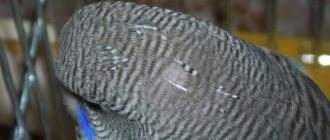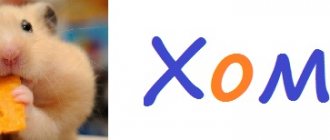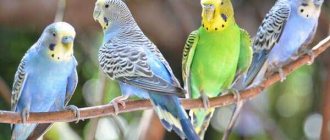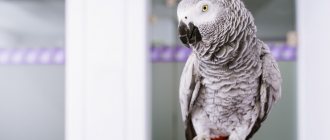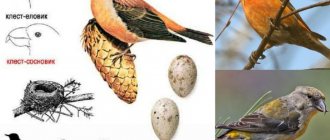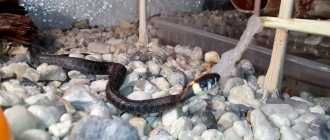12 March66284decorative birdsparrot
The budgerigar is a bird that is a popular pet. These birds are loved for their brightness and variety of colors, ability to speak and unpretentiousness. If you decide to get a feathered friend like a budgie, be prepared that they are noisy and talkative. In this article you will find a lot of new and interesting things about budgies.
Development by day
To understand how small wavy plants grow and develop, the following stages are taken into account:
- in the first three days the chicks are completely helpless, and they also lack plumage;
- on the sixth day, their egg tooth, which is necessary for breaking the shell, falls off, so from this moment the birds can raise their heads;
- a week after birth, the birds’ neck muscles become stronger, so they can easily hold their heads up, and also gradually open their eyes and try to sit up;
- on the 10th day, their gaze becomes more meaningful, and they also begin to clearly see surrounding objects;
- two weeks after birth, the first feathers appear on the back of the head and wings;
- by the end of the third week, the birds acquire full plumage with a specific color;
- after a month, the birds have an elongated tail, and the owner can determine the sex of each chick;
- after 40 days the birds begin to fly a little.
Wavys develop very quickly after birth. Although a person participates little in this process, he must provide optimal external conditions.
Particular attention is paid to nutrition, since the female not only eats on her own, but also feeds her offspring. Literally a month later the birds are not much different from their parents. The differences are only in the size of the body and plumage.
Appearance
They do not have an attractive appearance, since the birds are born completely naked and blind. They cannot move independently and also weigh only 1 gram. But after about three days their weight reaches 5 grams. They gain weight very quickly, and literally after 25 days they are practically no different in appearance from their adult parents.
Other features of newborn chicks include:
- they may have a few fluffs on their backs, but usually they are born completely naked;
- they are deaf and blind, so they cannot eat or move independently;
- they have an overly large head and long neck, as well as thin legs.
In the first days, the chicks just lie down. The female feeds them ground food from her crop.
In the photo there is a budgerigar chick:
Caring for parrot chicks
Parents carefully take care of their chicks and protect them in every possible way.
At first, feeding the small parrots is done exclusively by the female, who practically never leaves the chicks alone for a second.
During this period, it is important that the owner of the parrots also makes every effort to ensure that the parrots grow up healthy. First of all, it is necessary to feed the female in a balanced manner and monitor her health, since she herself cannot search for food.
First of all, it is necessary to feed the female in a balanced manner and monitor her health, since she herself cannot search for food.
The main task of the female is to feed her chicks
Therefore, you should pay attention to the female, and she, in turn, will worry about the little parrots.
The diet of a female parrot must include a large amount of animal protein so that the female has the energy she needs to care for and feed her chicks.
The chicks grow and develop at a fairly fast pace. After about a week, they have normal vision, which allows them to see this wonderful world.
At the same time, the male parrot joins the feeding process. There are still no feathers on the body of parrots, but the down becomes stiffer and denser.
Two weeks after birth, the female begins to gradually move away from the chicks
At this time, it is especially important to control the nutrition of small parrots.
Always make sure there is enough food in the feeder. Otherwise, the parrots may get hungry, which can negatively affect their health.
In some cases, adult parrots may stop feeding their chicks, in which case the task of feeding falls entirely on the owner.
Chicks require artificial feeding, which you will do.
If you don’t know how to determine whether chicks are hungry or not, then it’s very easy to do and much simpler than it might seem at first glance.
If parrots actively squeak and do this constantly, then you can be 100% sure that they are hungry.
It is the squeaking of parrots that is a signal that the chicks require additional feeding.
Is human care required?
The most optimal care is provided by the female, who protects and protects her offspring. She tries to pay attention to each chick, regardless of the number of birds. But sometimes babies need human help. For example, if a bird refuses its offspring for various reasons, then the babies can be fed artificially with special food, for which a special probe is used.
But usually the best help lies in nutritious and high-quality nutrition for the mother. Therefore, it is necessary to purchase a balanced grain mixture, as well as treat the female with vitamin supplements, minerals and fresh vegetables and fruits. It is important to regularly maintain optimal home hygiene and avoid excessive reduction in temperature or humidity.
Chick care
The correct diet for young animals is not the only thing that will allow the livestock to grow strong and healthy. You will also need to check the birds' nest once every 7 days. Sometimes the female can harm the baby or even crush it. Therefore, some babies may need assistance.
If a dead body is found in the nest, it must be removed and the rest of the stock washed with warm water. But it is better not to disturb the birds unless necessary.
Sometimes it is necessary to update the drinkers in the box. You will also need to monitor cleanliness. Therefore, it is better to do cleaning when the female is eating or taking baths.
Breeders will need to monitor the weight of their young animals. At the moment of birth they will be no more than 1 gram. But in the first couple of days their mass will grow quickly. Therefore, over such a period, the weight should be increased by 200%. The maximum weight of the bird will be somewhere on the 23rd day after birth.
These are all the features of feeding and raising parrots yourself. The main thing to remember is that a strong and healthy livestock is the result of the breeder’s efforts.
Arranging the nest and keeping it clean
Parrot chicks should be protected from hypothermia. In the wild, mothers warm them under their wings, but if this is not done, then organize the warmth yourself. This will be provided by a heating pad with warm water and a 60 W incandescent lamp. Comfortable conditions for chicks in the first days of life are 36 degrees. It is gradually reduced to 30-32 degrees, starting from three weeks of age - to 24 degrees. Three-week-old chicks are already beginning to fledge; thermoregulation becomes like that of adult birds, so they do not need additional insulation.
The nest of two-week-old babies will need to be thoroughly cleaned. During this period, the chicks are placed in an insulated box. Thoroughly clean all dirt and remove debris. Work quickly to keep the chicks from freezing. The crumbs themselves also need to be examined and, if necessary, cleaned of food debris. Pay special attention to the paws. If a lot of dirt sticks to them, there is a risk of deformation during growth. Heat the water and carefully clean the chicks.
First flight of chicks
Starting from the 24th day of life until the chick’s first flight from the nest, its weight decreases somewhat, which is explained by its energetic movements. As soon as the last chick flies out of the nest, the nest is carefully checked, as new clutches are often found there - eggs stained with droppings. They are transferred to a clean nest.
For an amateur, the flight of chicks is the moment of supreme pleasure. A chick sits on a branch, a little smaller than an adult parrot, with large dark eyes and amazingly examines the world around it. For the most part, the chicks fly nimbly and return to the nest already on the first day. Fully fledged, healthy chicks fly out of the nest at approximately 35 days of age. They are slightly smaller in size than their parents, the wavy on the head extends across the forehead to the base of the beak, and their coloring is less bright compared to their parents, their eyes are black, and there is a noticeable black spot at the tip of the beak. The cere and mandible of the chicks are pink, later - white with a bluish tint.
Chicks can be left with their parents in a cage for approximately 14 days after the last chick has fledged; They do not disturb subsequent nesting, since they no longer return to the nest. Then they need to be transplanted into a flying cage, where they fly freely, gradually turning into strong and healthy birds.
For a novice hobbyist who has hatched chicks for the first time, of course, there is a great temptation to look into the nest and see with his own eyes how the babies grow and develop. Usually the female reacts calmly to the owner’s intervention. Many birds remain calmly sitting on the clutch or brood, without particularly worrying. But it’s better not to do this, as there may be unpleasant consequences later in the form of pecked eggs or abandoned chicks. Therefore, in order to get a good look at everything, choose a moment when the bird is not there. Some birds become so accustomed to daily control by their owner that they even move aside or leave the nest.
"Portrait" from life: birth
So, the female laid several eggs in the nesting house and began to incubate them. After 19 days, the chick hatches from the first egg laid, and after a day or two, so to speak, in chronological order, the rest will begin to appear.
Newborn wavy chicks are born weighing literally 1-1.5 grams and look very unattractive and helpless: their pink-purple body is completely devoid of plumage, the future handsome ones have a disproportionately large head, which their long thin neck cannot even hold, and weak legs . Birds don't see or hear.
Reproduction of wavy birds.
How chicks hatch
In budgerigars, chicks are born approximately 18-20 days after the start of hatching. Healthy and well-developed chicks will break through the shell on their own - nature has endowed them with a special tooth in the upper part of the beak. Those who are too weak to hatch on their own are helped by the mother by breaking the shell with her beak.
Human assistance is not required at this stage. However, take care to create the desired level of humidity in the room - 60-65%. If the air is too dry, it will be more difficult for baby parrots to break through the hard shell of an egg. There is a film inside under the shell that can wrap around his body, and then mom will have to come to the rescue.
Selecting an incubator
You can buy the device or make it yourself.
It is recommended to focus on purchased models that are equipped with useful functions that allow you to maintain optimal temperature and humidity.
Pet stores offer a huge range of such products, which differ in size, built-in functions and cost.
Since you plan to grow wavy plants, it is advisable to choose models with a small laying.
Incubators for chicken eggs are usually purchased, and devices designed for three embedded materials are considered ideal.
When choosing a product, the following parameters are taken into account:
- a reliable housing that is hermetically sealed and does not let heat out;
- the tray should be presented as a flat container, but the eggs should not be rolled out, so they should be stored in the position in which a person leaves them;
- the turning device is offered only in expensive models, so to save money you can choose a product without it, but you will have to perform these actions manually;
- an electric heater is usually represented by an ordinary incandescent light bulb, and with its help the optimal temperature for the development of embryos is established;
- the cooling function is offered only by a limited number of devices, and without it you will have to ventilate the incubator yourself;
- Humidification is provided by automatic spraying of water, which makes it much easier for the chicks to break the shell, but in the absence of this function, you will have to spray the embedded material yourself from a regular sprayer.
It is recommended to purchase a battery-powered device, although it is expensive, but if the electricity in the apartment or house is turned off, the equipment will continue to work, so you don’t have to worry about the life of the embryos.
Before using any purchased device, study the instructions , thanks to which you can correctly configure the options that are optimal for growing wavy plants.
This is what a homemade incubator looks like:
More information about the incubator for budgie eggs in the video:
How often to feed chicks
Feed tiny parrots every two hours, with a break of four hours at night. In the future, six meals a day will be enough. On the twentieth day, the chicks can eat four times a day, and then three times will be enough.
When babies feel hungry, they begin to squeak loudly, and these sounds need to be taken into account. However, you should not overfeed your parrot. When the chicks grow up, try feeding them with a spoon - gradually they will get used to it. When one of the charges begins to eat on his own, he can become an example for his fellows.
The main product in the diet of small parrots is semolina porridge or millet. It can be mixed with previously hard-boiled chicken yolk. They even add a little fish oil to their food. When the birds sit confidently on the perch, you can give them thicker food. It is recommended to feed dry food to chicks that have learned to fly around the cage. When feeding liquid cereals, liquid is given in small quantities. But then she must constantly stand in the drinking bowl.
The parrot's body must have enough minerals
How does the courtship ceremony take place in birds?
A well-chosen pair exhibits behavior characteristic of displaying birds. The male gently pulls the feathers of his chosen one, making stealing sounds, and often feeds her from his beak.
Parrot courtship ceremony
The friend bows her head favorably in response and sits with half-closed eyelids. Birds kiss regularly and may dance and act in funny ways.
For example, the unusual mating behavior of arar in one of the zoos is described. In addition to the courtship above, the birds took turns lying on their backs, playfully pushing each other with their paws, running around with a nut in their beaks, and trying to take it away from each other.
How often to feed budgerigar chicks
The smallest chicks need to be fed every two hours, at night - every 4 hours. Gradually, the parrots are enough to feed six times with a break at night.
Photo: Dawnstar Australis
On the 20th day of life, babies can eat 4 times a day; as they approach 35 days, 3 times will be enough for the chicks.
When babies are hungry, they begin to squeak, and the owners, in addition to the feeding schedule, listen to the sounds coming from the cage.
If your adult bird is sick, you may need to feed it more often.
Try feeding them with a spoon, gradually the chicks will get used to it. If the eldest among them is the first to start eating on his own, there is a chance that he will become an example for the rest of the parrots.
What to do if your parrot laid an egg?
If this was part of your plans and you want your birds to have offspring, then you urgently need to hang a nest for the parrots. Then the bird will take up incubation. There is no need to help her or do anything; parrots always manage on their own. It is also not worth removing her gentleman from the cage, unless, of course, he slightly distracts her from an important process. If the female lives with you alone and suddenly begins to lay eggs, then you should reconsider her diet and slightly reduce daylight hours.
Parrot house
You need to buy a spacious cage so that there is enough space for all the necessary accessories and for games. Dimensions should not be less than 60x80 cm.
Budgerigars' homes are regularly cleaned. Therefore, a person’s hand should easily fit through the door. It's good if there is a removable bottom panel.
In the cage it is necessary to place everything necessary for the bird: a feeder, a drinking bowl, a bath. Proper bird care means careful selection of the necessary accessories.
Additional accessories
It is also important to take care of perches and toys for your budgies. Choose wooden perches suitable for the size of the bird.
Thin or wide perches cause deformation of the paws and provoke corns.
Cleaning
The cage will have to be cleaned 2 times a week. Use a damp cloth and soapy water to wash the fence and the inside of the bird house. It is better to use baking soda and warm water for cleaning. This way you can avoid poisoning your parrot with household chemicals. Clean the pan especially thoroughly, and after drying it, add a small layer of special sand, which is sold in pet stores.
The chick died. Why?
It always hurts a lot when you find a dead chick in a nest. Nothing seemed to foretell trouble. There are several reasons for the death of newborns:
- lack of food;
- hypothermia;
- underfeeding or mother abandoning offspring;
- aggressive attitude of one of the parents;
- an inexperienced mother could accidentally crush the baby;
- attack by a female ready for a new clutch.
Why can a parrot die?
A person who is going to seriously engage in breeding budgies at home must realistically imagine all the difficulties and pitfalls of this business in order for it to be successful.
What to feed budgies?
To prevent the bird from experiencing digestive problems, it is important to feed it properly.
The basis of the parrot's diet is millet, the percentage composition of which includes:
- Fifty - yellow.
- Twenty-five - white.
- Fifteen is red.
The remaining ten percent is filled with hulled oats. It is recommended to purchase special grain formulations offered by pet stores for feeding.
Normal nutrition for budgerigars involves the inclusion of:
- Fresh greens.
- Vegetables.
- Fruits and berries.
- Minerals.
Greenery is provided by dandelion leaves, plantain or clover. Radish or carrot tops will do.
In the absence of such, in winter you can germinate grains in a box installed on the windowsill. The ideal option is oats.
Year-round inclusion of vegetables in the menu is very useful. Their range is varied. It is recommended to add cucumbers, tomatoes, peppers (not bitter), zucchini, radishes, etc. to the diet.
The choice of fruits and berries includes apples, grapes, bananas, strawberries, etc. In the summer, you can give your pet some melon or watermelon.
Parrots will receive mineral components and calcium from mixtures purchased at pet stores. A varied diet is especially important for an old parrot, given possible health problems.
It is also recommended to regularly feed the birds boiled wheat, barley and other porridges. An indispensable condition is the regular renewal of clean drinking water in the drinking bowl.
Diet selection
Before you take your purchased budgie home, ask the seller what he fed the bird. Try not to change the diet - this will put a strain on the gastrointestinal tract and will be additional stress for the pet.
The budgie eats grains - millet, canary and hemp seeds, raw sunflower and pumpkin seeds (the latter are also good as an anthelmintic). The birds are also given sprouted seeds.

